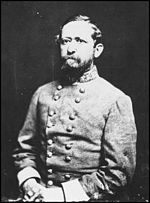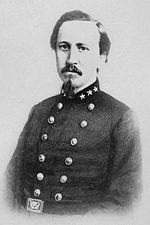
The Battle of Cross Keys was fought on June 8, 1862, in Rockingham County, Virginia, as part of Confederate Army Maj. Gen. Thomas J. "Stonewall" Jackson's campaign through the Shenandoah Valley during the American Civil War. Together, the battles of Cross Keys and Port Republic the following day were the decisive victories in Jackson's Valley Campaign, forcing the Union armies to retreat and leaving Jackson free to reinforce Gen. Robert E. Lee for the Seven Days Battles outside Richmond, Virginia.

The Army of the Shenandoah was a field army of the Confederate States Army active during the American Civil War. It was created to defend the Shenandoah Valley of Virginia from Union Army attacks during the early months of the war. The army was transferred to reinforce the Confederate Army of the Potomac at the First Battle of Bull Run, which was the only major engagement of the war it participated in. After the battle, the army was merged into the Army of the Potomac.

George Hume Steuart was a planter in Maryland and an American military officer; he served thirteen years in the United States Army before resigning his commission at the start of the American Civil War. He joined the Confederacy and rose to the rank of brigadier general in the Army of Northern Virginia. Nicknamed "Maryland" to avoid verbal confusion with Virginia cavalryman J.E.B. Stuart, Steuart unsuccessfully promoted the secession of Maryland before and during the conflict. He began the war as a captain of the 1st Maryland Infantry, CSA, and was promoted to colonel after the First Battle of Manassas.

During the American Civil War (1861–1865), Maryland, a slave state, was one of the border states, straddling the South and North. Despite some popular support for the cause of the Confederate States of America, Maryland did not secede during the Civil War. Governor Thomas H. Hicks, despite his early sympathies for the South, helped prevent the state from seceding.

The Maryland Army National Guard is the United States Army component of the U.S. state of Maryland. It is headquartered at the old Fifth Regiment Armory at the intersection of North Howard Street, 29th Division Street, near Martin Luther King, Jr. Boulevard in Baltimore and has additional units assigned and quartered at several regional armories, bases/camps and other facilities across the state.
A flying camp was a military formation employed by the Continental Army in the second half of 1776, during the American Revolutionary War.

Bradley Tyler Johnson was an American lawyer, soldier, and writer. Although his home state of Maryland remained in the Union during the American Civil War, it was still considered a Southern state and Confederate sympathies were common, and Johnson served as a brigadier general in the Confederate States Army, leading efforts to raise a Maryland Line in the CSA, and rising to command the 1st Maryland Infantry, CSA.

Arnold Elzey Jones Jr., known for much of his life simply as Arnold Elzey, was a soldier in both the United States Army and the Confederate Army, serving as a major general in the American Civil War. At First Manassas, he became one of the few officers ever to receive an on-the-field promotion to general by President Jefferson Davis. He commanded a brigade in Stonewall Jackson's Valley Campaign, and was badly wounded at Gaines Mill, ending his active field career.

George Hume Steuart (1790–1867) was a United States general who fought during the War of 1812, and later joined the Confederate States of America during the Civil War. His military career began in 1814 when, as a captain, he raised a company of Maryland volunteers, leading them at both the Battle of Bladensberg and the Battle of North Point, where he was wounded. After the war he rose to become major general and commander-in-chief of the First Light Division, Maryland Militia.
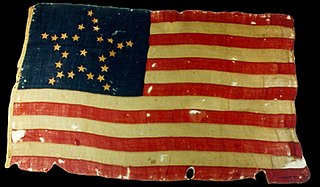
The 10th Virginia Infantry Regiment was an infantry regiment raised in Virginia for service in the Confederate States Army during the American Civil War. It fought mostly with the Army of Northern Virginia.

The 19th Virginia Infantry Regiment was an infantry regiment raised in Virginia for service in the Confederate States Army during the American Civil War. It fought mostly with the Army of Northern Virginia.
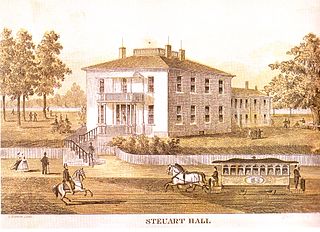
"Maryland Square", later known as "Steuart Hall", was a mansion owned by the Steuart family from 1795 to 1861, located on the western outskirts of Baltimore, Maryland, at the present-day junction of West Baltimore and Monroe streets. In the first year of the American Civil War, the property was confiscated by the United States Federal Government as its owner, George H. Steuart, a former United States Army officer, had resigned his commission to fight in the Confederate Army, in the Army of Northern Virginia as a brigadier general.
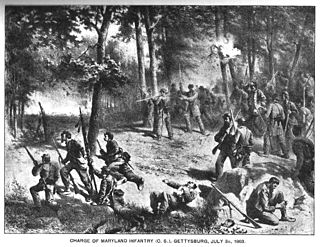
The Maryland Line in the Army of the Confederate States of America was made up of volunteers from Maryland who, despite their home state remaining in the Union, fought for the Confederate States of America during the American Civil War. Of approximately 25,000 Marylanders who volunteered, most fought in the Army of Northern Virginia, and it was not until late in 1863 that a Maryland Line in the CSA was formally created. However, by this late stage in the war, few men wished to leave the units they had fought alongside for more than two years, and the exiles' dream of an independent Maryland Line in the Confederate army would never be fully realized.

The 1st Regiment Maryland Volunteer Infantry was an infantry regiment that served in the Union Army during the American Civil War.
Like other border states, Maryland found herself in a difficult position at the start of the American Civil War, with loyalties divided between North and South. Although Maryland herself remained in the Union, Maryland militia units fought on both sides of the Civil War. Many militia members travelled south at the start of the war, crossing the Potomac River to join the Confederate Army of Northern Virginia.
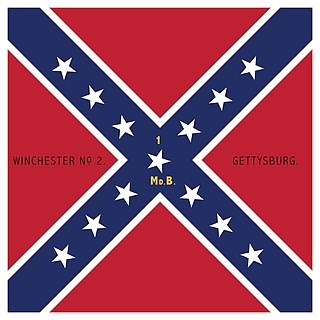
The 2nd Maryland Infantry Regiment was a Confederate infantry regiment made up of volunteers from Maryland who, despite their home state remaining loyal to the Union during the American Civil War, chose instead to fight for the Confederacy. The regiment was largely made up of volunteers from the 1st Maryland Infantry, CSA, which was disbanded in August 1862, its initial term of duty having expired. They saw action at many of the fiercest battles of the Civil War, taking part in the brutal fighting at Culp's Hill at the Battle of Gettysburg. The unit suffered such severe casualties during the war that, by the time of General Robert E. Lee's surrender at Appomattox Court House on April 9, 1865, only around forty men remained.

The First Light Division of Maryland Volunteers was a militia unit based in Baltimore and formed in around 1841. Its commander was the militia general George H. Steuart. Elements of the division participated in the suppression of John Brown's raid on Harper's Ferry in 1859, but its members found themselves in a difficult position at the outbreak of the American Civil War in 1861. Many of the citizen volunteers, especially the senior command, wished to secede from the Union and join the Confederate States of America. However, Maryland remained loyal to the Union during the Civil War and as a consequence of this the division was disbanded. Many of its members left Maryland and went south to fight for the Confederacy.

The 175th Infantry Regiment is an infantry regiment of the Maryland Army National Guard. It is one of several National Guard units with colonial roots and campaign credit for the War of 1812.

The 5th Regiment Massachusetts Volunteer Militia was a peacetime infantry regiment that was activated for federal service in the Union army for three separate tours during the American Civil War. In the years immediately preceding the war and during its first term of service, the regiment consisted primarily of companies from Essex County as well as Boston and Charlestown.
The 1st Maryland Cavalry Battalion was a small Confederate cavalry unit during the American Civil War.

